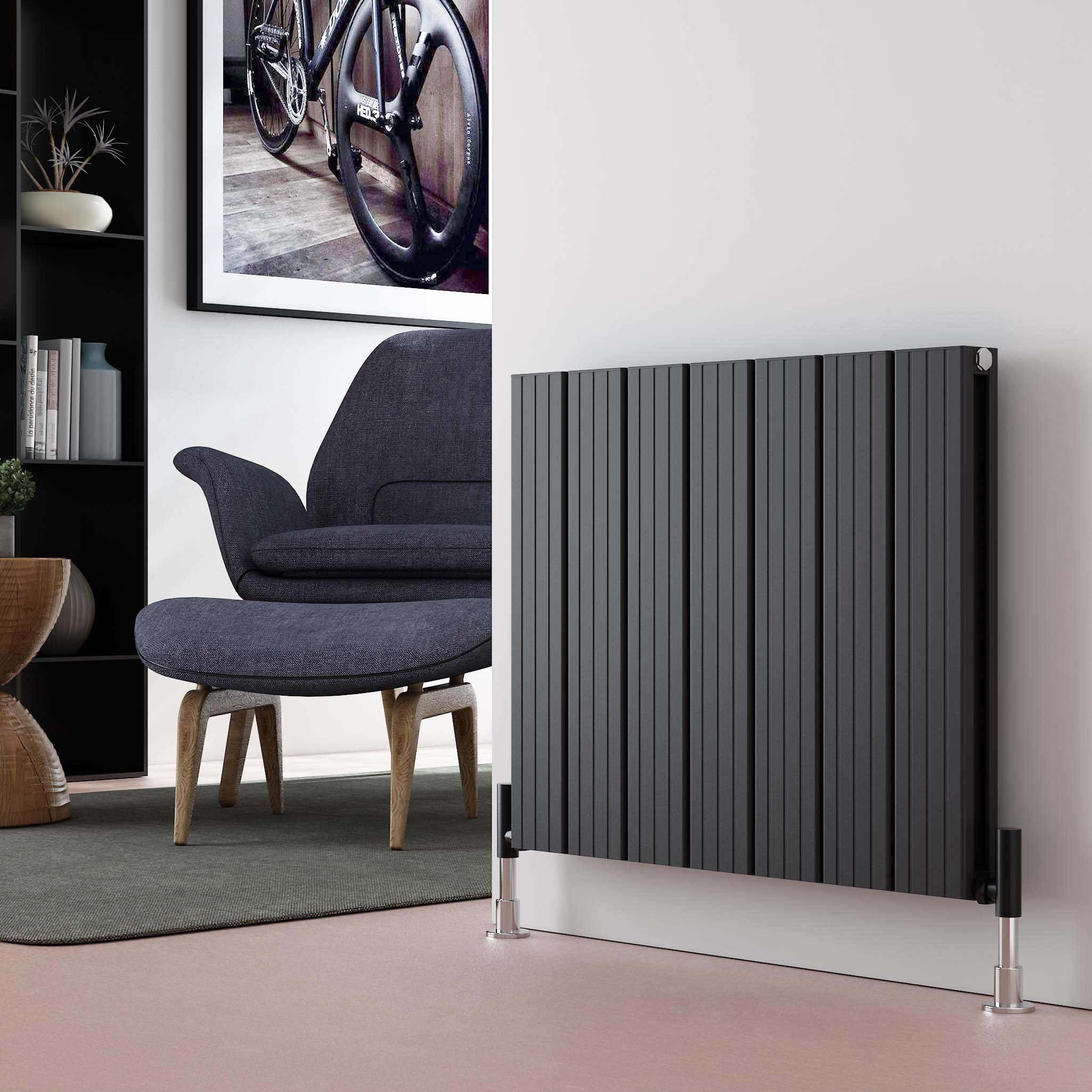Vertical vs Horizontal Radiators: The Best Designer’s Style

When selecting new radiators, the choice between vertical or horizontal models not only impacts aesthetics but also affects potential heating efficiency. This comprehensive guide examines the differences to help identify your best heating solution.
Vertical Radiators: Style or Sacrifice? Heat Output Myths Debunked
The sleek lines and contemporary allure of vertical radiators have undeniably stolen the hearts (and wall spaces) of modern homeowners. But amidst their undeniable aesthetic appeal, whispers of efficiency concerns linger. Are vertical radiators merely stylish sacrifices, or can they hold their own against their horizontal counterparts when it comes to warming your home?
The Physics of Heat: A Tale of Two Orientations
Science dictates a slight disadvantage for vertical radiators. Traditional physics tells us that heat rises. Horizontal radiators, with their wider surface area, effectively draw in cold air at the bottom, heat it as it rises, and circulate the warmed air throughout the room. Vertical radiators, though tall and elegant, have less horizontal surface area, potentially drawing in and heating less air overall.
However, before you banish vertical radiators to the realm of purely decorative accents, consider these key points:
- Convection Currents and Furniture Foes: While horizontal radiators boast wider heat intake, their nemesis often lurks nearby – furniture. Sofas, armchairs, and even curtains can easily obstruct their airflow, significantly hindering their efficiency. Vertical radiators, with their slim profile, are less prone to such blockades, allowing for more consistent heat distribution.

Vertical Radiators: More Than Just a Pretty Face
Beyond the realm of physics, vertical radiators offer practical advantages that extend far beyond aesthetics:
- Space Savvy: In small or awkwardly shaped rooms, where wall space is a precious commodity, vertical radiators shine. Their slender forms fit snugly between windows, doors, or narrow walls, maximizing space utilization without compromising on warmth.
- Design Freedom: Gone are the days of radiators dictating furniture placement. Vertical radiators liberate you from the “keep-clear” zone, allowing you to arrange furniture freely and express your interior design vision.
- Double Duty Delights: For bathrooms and bedrooms, vertical mirror radiators combine heat with function, eliminating the need for separate mirrors and saving precious wall space. Talk about double the delight!
- Artful Accents: Vertical radiators transcend utilitarian heating to become statement pieces. Boldly colored designs, sleek metallic finishes, and even art-inspired motifs transform them into conversation starters and focal points of your space.
BTU: The True Measure of Warmth
Ultimately, when it comes to heating your home, the orientation of your radiator pales in comparison to its heat output. The British Thermal Unit (BTU) reigns supreme as the king of heating efficiency. One BTU signifies the amount of energy required to raise the temperature of one pound of water by one degree Fahrenheit. So, as long as your chosen radiator, whether vertical or horizontal, meets the BTU requirements of your room, it will deliver the desired warmth, regardless of its orientation.
Choosing the Right Radiator: Beyond Style
While aesthetics play a vital role, choosing the right radiator demands a holistic approach. Consider these factors:
- Existing Pipework: Replacing an existing radiator often means working with existing pipework. If altering the plumbing isn’t your cup of tea, opt for radiators compatible with your current setup. However, if maximizing space and aesthetics are priorities, revamping the plumbing could be a worthwhile investment.
- BTU Calculations: Don’t underestimate the power of a good BTU calculator. Accurately assess your room’s heat loss to determine the ideal BTU output for your radiator. Remember, an underpowered radiator will leave you shivering, while an overpowered one will burn a hole in your wallet.
- Professional Guidance: Unsure where to begin? Consult a heating expert! They can guide you through the maze of BTU calculations, radiator options, and installation considerations, ensuring you choose the perfect radiator for your needs and budget.
Heating Grants and Energy Savings: Warming Your Pockets Too
In the UK, the government offers various heating grants and incentives to help homeowners improve energy efficiency. Explore schemes like the Boiler Upgrade Scheme or the ECO4 program to potentially receive financial assistance for upgrading your heating system, including radiators. Remember, energy-efficient radiators not only benefit your wallet but also contribute to a greener planet.
Energy Saving Tips: Keep the Cosy Going
Maximize your radiator’s efficiency with these clever tips:
- Bleed Regularly: Air trapped in your radiator can hinder heat output. Bleed your radiators periodically to ensure optimal water flow and heat distribution.
- Insulate with Love: Insulating your walls and windows prevents heat from escaping, allowing your radiators to work less and save you money.
- Programmable Perfection: Invest in a programmable thermostat to automatically adjust heating based on your daily routine, ensuring warmth only when needed.
How Efficient Are Vertical Radiators?
Vertical radiators work on the same heating principles as horizontal models. However:
- Heat naturally rises in rooms via convection currents
- Horizontals have wider surfaces to slowly heat rising air
- Verticals fully heat air before it reaches top sections
This means verticals operate slightly less efficiently – although real world differences are small once properly sized and positioned.
Well matched modern vertical radiators only use around 5-10% more energy to achieve similar heat outputs. And without furniture obstruction, their performance further improves.
So while verticals may appear less efficient on paper, results can prove just as good in practice. Factors like optimised surface design, unblocked positioning and correct sizing compensate well in real homes.
Key Benefits of Vertical Radiator Installations
1. Maximise Limited Space
- Slender profile suits compact rooms lacking wall width
- Slot neatly between windows or doors
2. Increase Interior Design Scope
- Less clearance space aids flexible furniture layouts
- Integrate stylishly with decors unlike functional horizontals
3. Enable Creative Heating Solutions
- Solve tricky small spaces like narrow alcoves
- Double up as a heat source plus mirror or art display
When space comes at a premium, vertical models provide elegant and practical room heating capabilities.
Achieving Optimal Efficiency from Vertical Radiators
Follow this expert advice to maximise energy efficiency from your vertical radiators:
Accurately Size Models
Use a BTU calculator to establish heating requirements and pick units with adequate capacity. Over or under-sizing damages efficiency.
Position Carefully
External walls without windows or drafts allow units to best heat internal air.
Include High Quality Valves
Models with integrated thermostatic control help better regulate room temperatures.
Taking the time to size, site and fit vertical radiators correctly ensures you obtain their full heating potential in your home.
Style and Finish Options
As well as offering space-saving formats, vertical radiators also provide varied styles to suit room schemes:
Materials – Steel, aluminium, stainless steel
Built-in Extras – Integrate storage, mirrors or art
Colour Choices – Standard white plus special RAL colour matching
This rich mix of sizes, shapes and finishes enables vertical models to deliver functionality alongside stylish aesthetics.
Top 5 Vertical Radiators Recommendations
After comprehensively assessing many options against performance, reliability and cost criteria – these 5 models stand out:
1. Stelrad Column Plus
With its 10 year warranty and sleek anthracite colours this thin model adapts well into modern homes.
2. H Hudson Reece
A mid-priced British built anthracite column storing warmth via oil fluid technology for steady comfortable warmth.
3. MYSON Premier Compact
Using a clever multi-finned flat surface for increased heat outputs. Corrosion and rust resistant too.
4. Blyss Buckingham
This painted steel vertical incorporates useful hanging racks alongside an extended heating surface offering quicker warm ups.
5. Northern Heating Buckinghamshire
On a tight budget? This simple column still delivers efficient heating but at an affordable entry-level cost.
FAQs
Do vertical radiators heat a room as well?
When sized correctly for the space and heating demand, vertical models perform nearly as well as horizontal ones.
Is a vertical radiator better next to a window?
No, the localised cooling effect of windows still makes this an suboptimal position.
Can I reuse existing pipework if changing radiator orientation?
It depends on the layout – you may need to extend pipes or create new connections to match new inlet positions.
Key Takeaways
- Small efficiency differences between vertical and horizontal radiators
- Ensure adequate BTU rating for room size when selecting
- Position carefully on external walls away from windows
- Vertical models enhance interior design options
- Creative integrated or painted colour finishes available
Make an informed choice balancing your aesthetic tastes, space constraints and heating requirements.
Lower Energy Bills with these Quick Tips
Turn off Radiators in Unused Rooms
Close valves or timers in spaces not requiring heating.
Use Radiator Reflector Panels
Foil-backed boards prevent heat waste through exterior walls.
Install Thermostatic Radiator Valves
Self-regulating TRVs prevent rooms overheating – saving energy.
Insulate Your Pipework
Prevent precious heat leaking away before reaching radiators by lagging pipes.
Bleed Your Radiators
Manual venting improves efficiency by removing trapped air bubbles.
Could You Receive a Free Heating Grant?
If claiming certain benefits, you may qualify for sizable grant funding towards:
- New gas central heating systems
- Full fuel switches from oil or electric to gas
- Boiler unit upgrades plus controls
- Enhanced insulation and draughtproofing
Use the Simple Energy Grant eligibility checker to see if funding of £10,000+ could transform your home heating for free.



